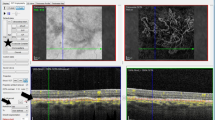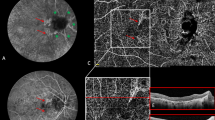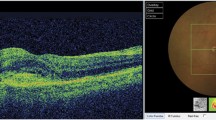Abstract
Background
To correlate the volume of various spaces on optical coherence tomography (OCT) with fluorescein angiographic (FA) parameters in neovascular age-related macular degeneration (AMD).
Methods
Sixty-five consecutive cases of active subfoveal choroidal neovascularization (CNV) associated with AMD were retrospectively collected. Area and greatest linear dimension of CNV lesion components were calculated on FA. Corresponding StratusOCT image sets were analyzed using custom software (termed OCTOR), which allows manual measurement of the volume of the neurosensory retina, subretinal fluid, subretinal tissue, and pigment epithelial detachment (PED).
Results
Area of occult CNV on FA correlated with PED (R = 0.62) and subretinal fluid (R = 0.28) volume and negatively with subretinal tissue volume (R = −0.26) on OCT. Area of classic CNV on FA correlated with subretinal tissue (R = 0.60) and retinal (R = 0.38) volume on OCT. Automated StratusOCT output values showed poorer correlations than manually calculated OCTOR values.
Conclusions
OCT features of CNV lesions as measured by manual quantitative subanalysis correlate better with angiographic parameters than values provided by the automated StratusOCT analysis. These measures may improve our understanding of the morphologic effects of CNV lesions and may facilitate the development of a hybrid FA and OCT-based classification system for future clinical trials, which more fully characterizes CNV lesions.




Similar content being viewed by others
References
Barbazetto I et al (2003) Photodynamic therapy of subfoveal choroidal neovascularization with verteporfin: fluorescein angiographic guidelines for evaluation and treatment-TAP and VIP report No. 2. Arch Ophthalmol 121:1253–1268
Fung AE, Lalwani GA, Rosenfeld PJ et al (2007) An optical coherence tomography-guided, variable dosing regimen with intravitreal ranibizumab (Lucentis) for neovascular age-related macular degeneration. Am J Ophthalmol 143:566–583
Gross NE, Aizman A, Brucker A et al (2005) Nature and risk of neovascularization in the fellow eye of patients with unilateral retinal angiomatous proliferation. Retina 25:713–718
Joeres S, Tsong JW, Updike PG et al (2007) Reproducibility of quantitative optical coherence tomography sub-analysis in neovascular age-related macular degeneration. Invest Ophthalmol Vis Sci 48:4300–4307
Joeres S, Kaplowitz K, Brubaker JW et al (2008) Quantitative comparison of optical coherence tomography after Pegaptanib or Bevacizumab in neovascular age-related macular degeneration. Ophthalmology 115:347–354
Keane PA, Liakopoulos S, Ongchin SC et al (2008) Quantitative subanalysis of optical coherence tomography after treatment with Ranibizumab for neovascular age-related macular degeneration. Invest Ophthalmol Vis Sci 49:3115–3120
Kozak I, Morrison VL, Clark TM et al (2008) Discrepancy between fluorescein angiography and optical coherence tomography in detection of macular disease. Retina 28:538–544
Laser photocoagulation of subfoveal neovascular lesions of age-related macular degeneration. Updated findings from two clinical trials. Macular Photocoagulation Study Group. Arch Ophthalmol 111:1200–1209
Liakopoulos S, Ongchin S, Bansal A et al (2008) Quantitative optical coherence tomography findings in various subtypes of neovascular age-related macular degeneration. Invest Ophthalmol Vis Sci 49:5048–5054
Ray R, Stinnett SS, Jaffe GJ (2005) Evaluation of image artifact produced by optical coherence tomography of retinal pathology. Am J Ophthalmol 139:18–29
Sadda SR, Wu Z, Walsh AC et al (2006) Errors in retinal thickness measurements obtained by optical coherence tomography. Ophthalmology 113:285–293
Sadda SR, Joeres S, Wu Z et al (2007) Error correction and quantitative sub-analysis of optical coherence tomography data using computer-assisted grading. Invest Ophthalmol Vis Sci 48:839–848
Sandhu SS, Talks SJ (2005) Correlation of optical coherence tomography, with or without additional colour fundus photography, with stereo fundus fluorescein angiography in diagnosing choroidal neovascular membranes. Br J Ophthalmol 89:967–970
Soliman W, Sander B, Hasler PW et al (2008) Correlation between intraretinal changes in diabetic macular oedema seen in fluorescein angiography and optical coherence tomography. Acta Ophthalmol 86:34–39
Talks J, Koshy Z, Chatzinikolas K (2007) Use of optical coherence tomography, fluorescein angiography and indocyanine green angiography in a screening clinic for wet age-related macular degeneration. Br J Ophthalmol 91:600–601
van Velthoven ME, de Smet MD, Schlingemann RO et al (2006) Added value of OCT in evaluating the presence of leakage in patients with age-related macular degeneration treated with PDT. Graefes Arch Clin Exp Ophthalmol 244:1119–1123
Van de Moere A, Sandhu SS, Talks SJ (2006) Correlation of optical coherence tomography and fundus fluorescein angiography following photodynamic therapy for choroidal neovascular membranes. Br J Ophthalmol 90:304–306
Yannuzzi LA, Negrao S, Iida T et al (2001) Retinal angiomatous proliferation in age-related macular degeneration. Retina 21:416–434
Author information
Authors and Affiliations
Corresponding author
Additional information
Results of this study were presented as a poster at the 106th DOG annual meeting in September 2009.
This study was supported in part by NIH Grant EY03040 and NEI Grant R01 EY014375.
Drs. Walsh and Sadda are co-inventors of Doheny intellectual property related to optical coherence tomography that has been licensed by Topcon Medical Systems and are members of the scientific advisory board for Heidelberg Engineering. However, it is not related to the article’s subject matter.
Rights and permissions
About this article
Cite this article
Sadda, S.R., Liakopoulos, S., Keane, P.A. et al. Relationship between angiographic and optical coherence tomographic (OCT) parameters for quantifying choroidal neovascular lesions. Graefes Arch Clin Exp Ophthalmol 248, 175–184 (2010). https://doi.org/10.1007/s00417-009-1193-4
Received:
Revised:
Accepted:
Published:
Issue Date:
DOI: https://doi.org/10.1007/s00417-009-1193-4




